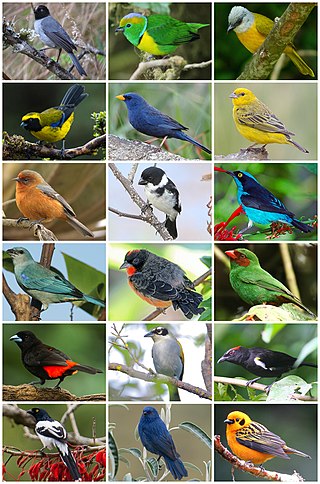
The tanagers comprise the bird family Thraupidae, in the order Passeriformes. The family has a Neotropical distribution and is the second-largest family of birds. It represents about 4% of all avian species and 12% of the Neotropical birds.

Haplospiza is a small genus of birds in the tanager family Thraupidae. Formerly classified in the bunting and American sparrow family Emberizidae, more recent studies have shown it to belong in the Thraupidae. Its two members breed in subtropical or tropical moist forest in Central and South America. They are often associated with bamboo.

The blue-and-gold tanager is a species of bird in the family Thraupidae. It is found in Costa Rica and Panama. Its natural habitats are subtropical or tropical moist lowland forests and subtropical or tropical moist montane forests. It is threatened by habitat loss.
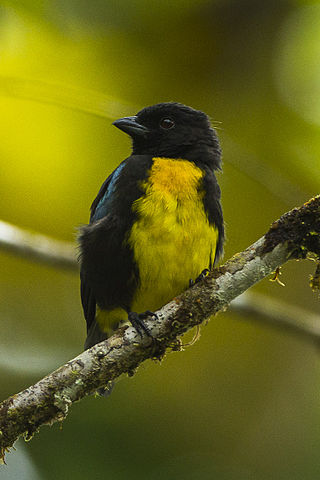
The black-and-gold tanager is a species of bird in the family Thraupidae. It is endemic to Colombia.

The golden-chested tanager is a species of bird in the family Thraupidae. It is found in Colombia and Ecuador. Its natural habitats are subtropical or tropical moist lowland forests and subtropical or tropical moist montane forests.

The black-chested mountain tanager is a species of bird in the family Thraupidae.
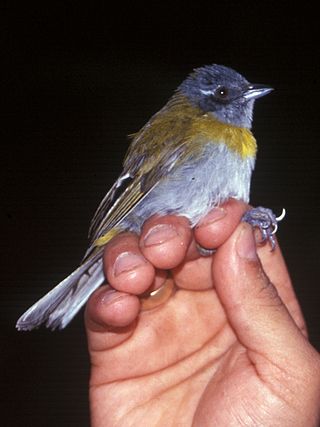
The ashy-throated bush tanager is a species of bird traditionally placed in the family Thraupidae, but perhaps closer to Arremonops in the Passerellidae. It is found in Colombia, Costa Rica, Ecuador, Panama, Peru, and Venezuela. Its natural habitats are subtropical or tropical dry forests, subtropical or tropical moist lowland forests, and subtropical or tropical moist montane forests.
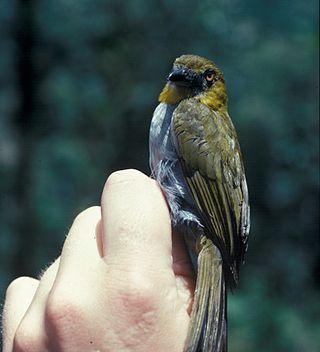
The yellow-throated bush tanager is a species of bird traditionally placed in the family Thraupidae, but now closer to Arremonops in the Passerellidae. It is found in Bolivia, Colombia, Ecuador, Panama, and Peru.

The Pirre bush tanager is a species of bird traditionally placed in the family Thraupidae, but now viewed closer to Arremonops in the Passerellidae. It is endemic to Panama. Its natural habitat is subtropical or tropical moist montane forests.
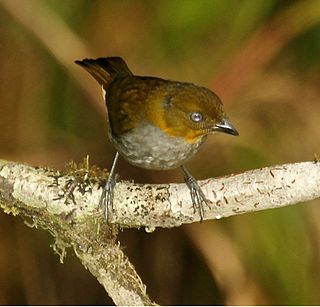
The yellow-whiskered bush tanager or short-billed bush-tanager is a species of bird traditionally placed in the family Thraupidae, but now viewed closer to Arremonops in the Passerellidae. It is found in Bolivia, Colombia, Ecuador, and Peru.

The dusky bush tanager is a species of bird traditionally placed in the family Thraupidae, but now viewed closer to Arremonops in the Passerellidae.

The Tacarcuna bush tanager is a species of bird traditionally placed in the family Thraupidae, but now viewed closer to Arremonops in the Passerellidae.

The black-masked finch is a species of South American bird in the tanager family Thraupidae. It is the only member of the genus Coryphaspiza. It is found in Argentina, Bolivia, Brazil, Paraguay, and Peru. Its natural habitats are subtropical or tropical moist shrubland, subtropical or tropical dry lowland grassland, and subtropical or tropical seasonally wet or flooded lowland grassland. It is threatened by habitat loss.

The yellow-shouldered grassquit is a species of bird in the tanager family Thraupidae that is endemic to Jamaica. It is the only member of the genus Loxipasser. Its natural habitats are subtropical or tropical moist lowland forest, subtropical or tropical moist montane forest, and heavily degraded former forest.
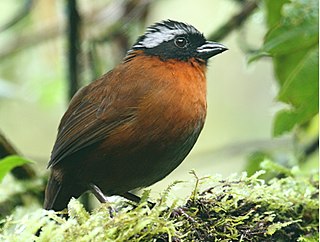
The tanager finch is a songbird species. In spite of its common name, it is neither a tanager nor a finch, but a New World sparrow, having been moved to that family after variously being placed in either the Emberizidae or the true tanager family Thraupidae. It is the only species in the monotypic genus Oreothraupis. It is found in Colombia and Ecuador, where its natural habitat is subtropical or tropical moist montane forests. It is threatened by habitat loss.

The bay-chested warbling finch is a species of bird in the family Thraupidae. It is endemic to southeastern Brazil.

The blue-and-yellow tanager is a species of bird in the tanager family Thraupidae.
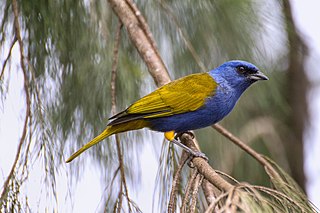
The blue-capped tanager is a species of bird in the tanager family Thraupidae. It was formerly placed in the genus Thraupis but is now the only species in the genus Sporathraupis.

The Cuban grassquit is a small bird in the tanager family Thraupidae. It is endemic to Cuba.

The black-backed bush tanager, also known as the black-backed bush-finch, is a species of bird in the family Thraupidae. It is the only member in the genus Urothraupis. It is found in Colombia and Ecuador. Its natural habitat is subtropical or tropical moist montane forests.






















